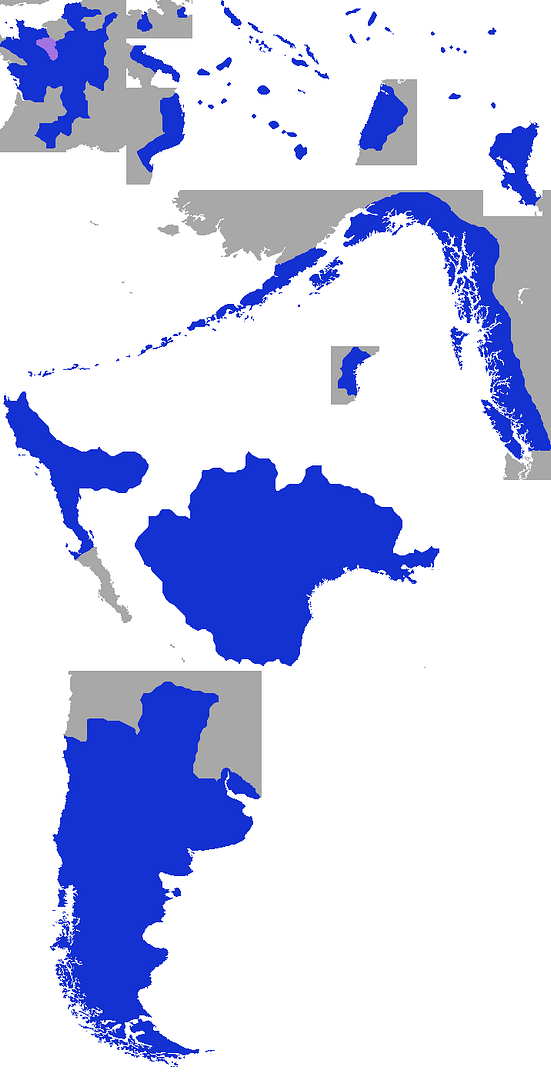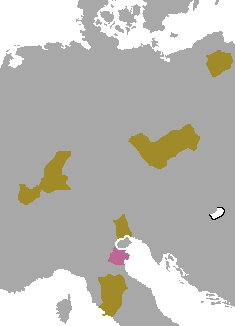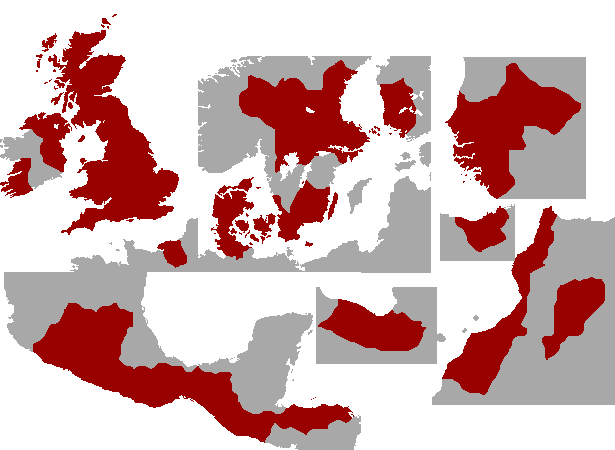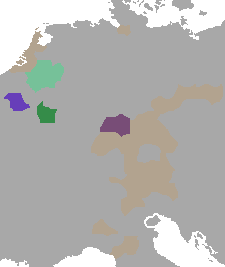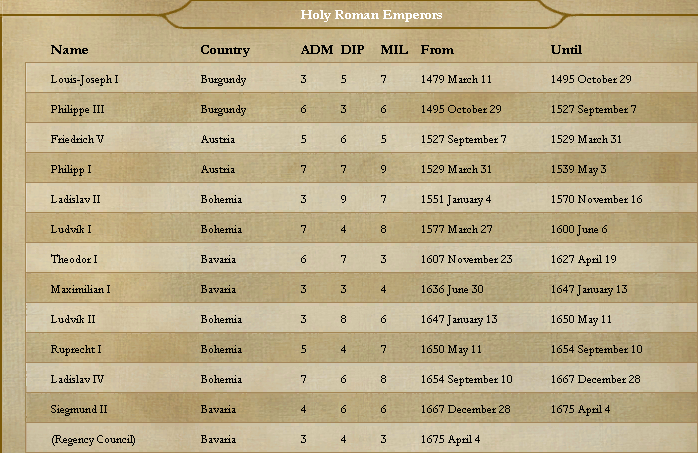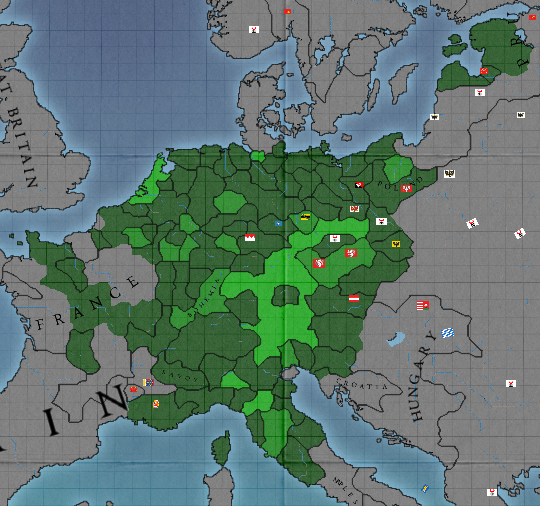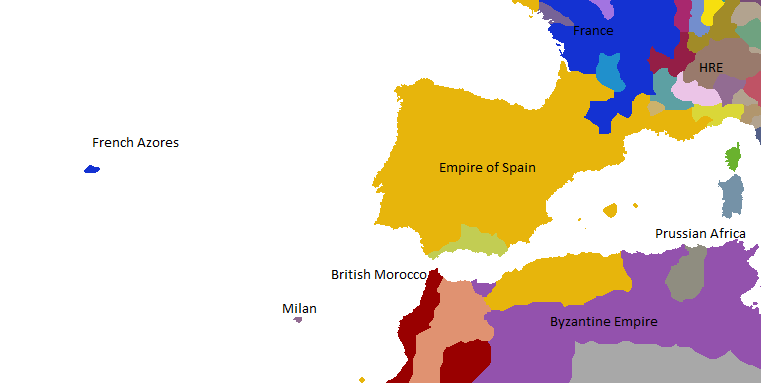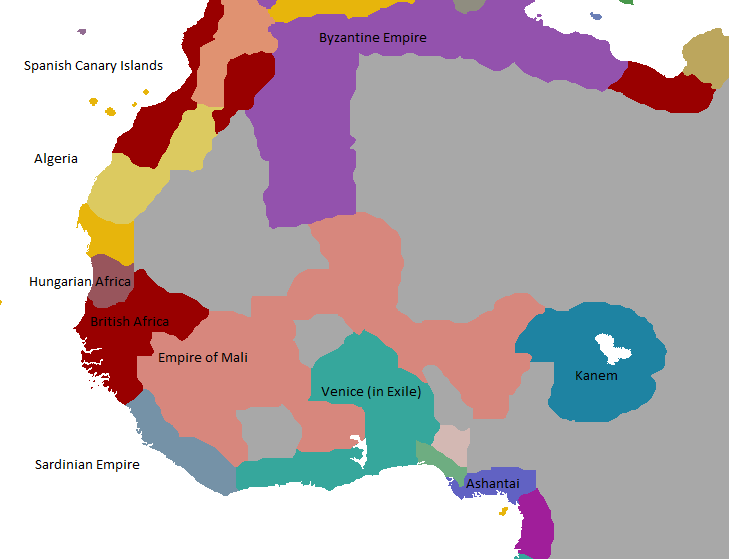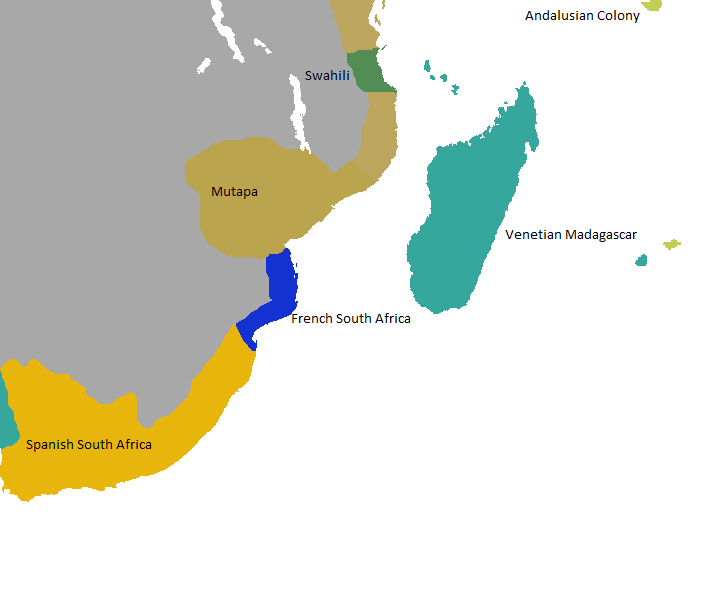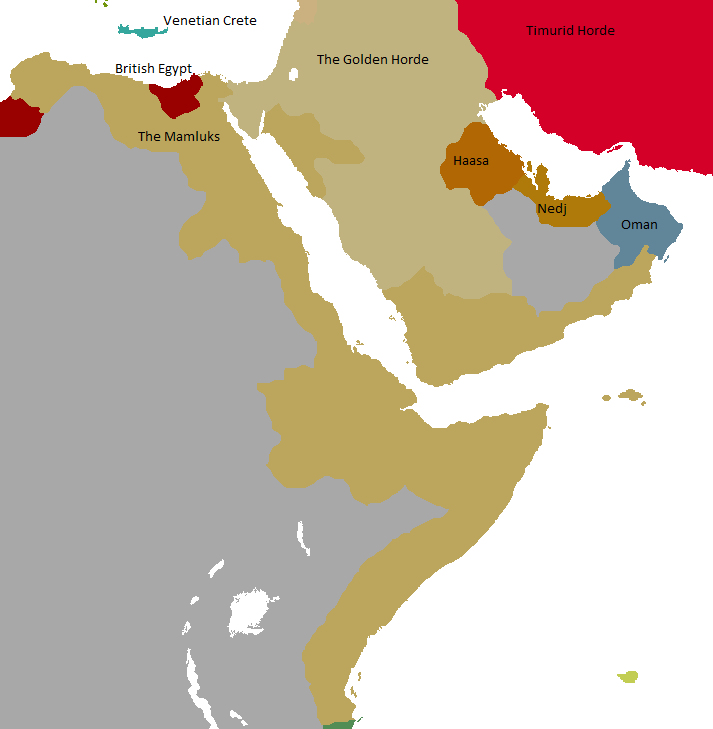The Holy Roman Empire
Since the second time the Bohemians lost the throne in in 1600 A.D. The Holy Roman Empire has been a volatile place. Initially the Holy Roman Empires were able to defend the borders of the HRE, but as time went on this attribute quickly ceased to exist. The Bavarians under the Askanier Dynasty were able to stabilize the Holy Roman Empire, in no small part do to their relations with the Golden Hore, which was a strong ally of the Askaniers. The Askaniers, while good at protecting the Empire, did little to bring about unity. The Askaniers regularly tolerated the presence of heretic nations within their midst, including the elector state of Tirol. This ultimately lead to their deposition. The true irony behind this was that Bavaria was chosen over Bohemia's Ladislav III (The last true Bohemian Friend to the Golden Horde) was that Bohemia was being much too soft on heretical beliefs.
Bohemia after becoming the next Holy Roman Empire quickly fell into disorder and disarray. Ludvik II, who came to power on the promise of crushing heresy within the Empire, was much too thorough at his job. Even Catholics who embraced the counter reformation were deemed too "heretical" for the Empire causing the Bohemians to all but abandon many nations that needed their help. Initially the Theocracies supported Bohemia, but during the reign of Ladislav IV it became apparent that there was no justifiable way to keep the Bohemians in power after they annexed several HRE nations with no proper claim to them. The Emperor was supposed to
protect the Empire, not destroy it and claim it for his own. This, along with some clever diplomacy, brought the Bavarians back in power. The Bavarians were, however, de Valois. The Askanier family was kicked out of Bavaria and many fled to Sarai where they were granted nobility status. Ironically enough the Golden Horde was one of the primary reasons for their removal from power.
The Bavarians in power now are at their height. Continuing the good relations with the Khaganate they have become one of the most powerful forces in Europe. While still very young, the second Bavarian Emperor, Luitpold III has shown remarkable talents in diplomacy and administration. These talents are, at the moment, delegating the right people to the right tasks, but in time the Bavarians will be headed by a strong effective leader in Europe. One of the more important problems with the HRE at the moment has been maintaining Imperial integrity. There are Six nations which own territory belonging to the Holy Roman Empire, these are: The Empire of Spain, The Empire of France, the Kingdom of Prussia, the Kingdom of Hungary, the Kingdom of Sweden, and the Khaganate of the Golden Horde. All four of these states are very powerful, but Bavaria knows that in order to maintain its popularity it will have to retrieve more of these provinces. At the moment a great boon to their cause was the retrieval of territory from the Golden Horde being the first nation in history to do so. Time will tell if Bavaria will be able to retrieve more territory. If not then conflict may be inevitable.
List of Holy Roman Emperors
Land currently accepted to be a part of the Holy Roman Empire
An Overview of the Holy Roman Empire
There are 57 independent countries within the Holy Roman Empire and exactly 134 territories within the empire.
At the head of the Empire we have the Holy Roman Emperor Luitpold III of the de Valois and his home nation of Bavaria. He commands an army of 248,200 men. The Bavarian Army is the fifth largest in the world behind only the Khaganate (519,500), France (376,141), The Timurid Horde (280,395), and The Empire of Spain (275,000). Bavaria controls 18 territories within the Holy Roman Empire. Bavaria in an Administrative Monarchy. Bavaria herself is not an elector and is thus much more vulnerable to a change in Emperor than Bohemia.
After the Emperor the next highest position of power within the Empire are the electors. There are currently seven of these electors. They are Bohemia, Cologne, Mainz, Saxony, Trier, Hainaut, and Luxembourg. Of the seven states three are Archbishoprics. The remaining four are Kingdoms, but all of them belong to the de Valois Dynasty. Onto the electors themselves, the most powerful elector is the Kingdom of Bohemia, a former seat of the Holy Roman Emperor. It's King, Ferdinand II de Valois, commands an army of 76,000 men, easily catapulting them to the position of second strongest nation within the HRE. They are also the twelfth strongest nation in the world. They have domain over 9 Territories inside the Empire making them the second largest state within the Empire. Unlike Bavaria, the Bohemian Kingdom is an Absolute Autocracy, not an administrative Kingdom. They are also voting for themselves in the upcoming election for Emperor. They are, however, alone in this regard. Ferdinand, in addition to being King of Bohemia, is King of Ferrara as well.
After Bohemia, the strongest elector is Cologne. Archbishop Gebhard III commands an army of 9000 men even if he controls just one city. Cologne is a firm backer of the Bavaria. Gebhard's namesake, Gebhard II was one of the firm backers of Bavaria back when politics inside the Empire were a lot more climactic. Nowadays succession of the throne is all but assured to the spawn of Luitpold de Valois.
After Cologne we have the King of Saxony, Johann. The Kingdom of Saxony is one of the last remaining holdouts of the electors to keep their dynasty. Saxony lived through the von Wettens until a century or two ago where the von Welfs took over. Since then Saxony has remained strong and independent from foreign powers. This has mostly been do to diplomatic manipulation rather than the power of Saxony. The King has just 7000 troops to his name and a single province. Johann is, however, an exemplary diplomat and military commander (8-3-8). Saxony is backing Bavaria.
After Saxony there are two electors which are relatively equal in position. These are the Archbishops of Mainz and Trier, Johann III and Frederick Karl Joseph. Each command 6000 men and each have a single city. Their forces, however, have fought against the Khaganate on more than one occasion. They are sometimes regarded as the immortal electors for the Khaganate, while it would destroy their armies, would never truly take the time to march through the HRE to get to them, even if they had the ability, which they most certainly do. The two archbishops are behind Bavaria.
The last of the electors are the Grand Duchies of Luxembourg and Hainaut. Hainaut controls an army of 6000 men, while Luxembourg controls just 4000 making it the weakest of all the electors inside the HRE. Duke Albert de Valois is in charge of Hainaut, while Duchess Elizabeth II rules inside of Luxembourg. The Duchess Elizabeth holds the honor of being the only female elector inside the Holy Roman Empire, her predecessor in Pisa was among the last female elector. Both of these states are aligned to the Bavarian faction and are thus voting for Luitpold's relatives inside of Bavaria to succeed him in the case of his demise. Both states have just one territory to their name.
In the past 75 years, a few elector states have remained the same, but a few notable nations are no longer Electors. The Kingdoms of Tirol and Pisa are the electors that have lost their position. The Kingdom of Pisa lost the position after a minor feud with the Emperor lead to their losing of the position. The Viscouti still reign in Pisa, however. The Heretical Elector of Tirol was annexed by Bavaria following their consolidation as Emperor of the Holy Roman Empire for fear that allowing their existence will end their reign before it began. This turned out to be an unnecessary move as any elector would go for Bavaria over Bohemia, but it occurred anyways.
Of the remaining forty-nine sovereign states within the Empire, they are divided into four groups. The first of the groups are the powerful nations which have made a name for themselves within the Empire. They are either accidents of dynastic ebb and flow, or crafty diplomacy in getting a reason for each new territory they acquire. After these forces there are the Monarchies, the Archbishoprics, and the Revolutionaries which have gained a large amount of popularity recently.
Powerful States of the Holy Roman Empire
The Republican Dictatorship of Switzerland, headed by Lord Protector Heinrich Aebi. He controls 7 territories within the Empire. Leading the largest Reinlander state, he controls an army of 37,000 men making them the third strongest nation within the Holy Roman Empire. They rank 18th in the world. They are a Catholic Nation.
The Kingdom of Burgundy, controlled by King Philippe IV of the Lorraine Dynasty. The Kingdom of Burgundy controls 3 territories within the Empire. The state is Burgundian, and it controls three Burgundian territories. After a war with France they were initially exiled with only a single province in Brandenburg. It's capital, Berlin, has long since abandoned it's saxon roots and is now a fully Burgundian city. When two Burgundian Provinces defected to Burgundy, Burgundy embraced them but kept their capital far from French eyes. Burgundy controls an army of 20,000 men making it fourth inside the Empire in terms of strength. 25th in terms of global standards. The Kingdom of Burgundy is Protestant, and is strong enough to resist Bavarian influence.
The Kingdom of Brabant, lead by its King Philippe V de Valois, is the fifth in terms of power inside of the Holy Roman Empire. 26th in the world. Philippe leads an army of 18,926. Normally Brabant would be considered stronger than Burgundy, but recently it suffered a number of rebellions and have struggled to keep the state in order. Brabant controls 3 territories. Brabant is also a protestant state. The Protestant faith has avoided the fate of the Orthodox Christian branch and has retained its strength inside the wake of struggle. It also doesn't hurt that Brabant is more than strong enough to resist Bavarian influence.
The Kingdom of Poland is next in terms of strength. It's monarch is King Fyredryk of the Saboisky dynasty of the newly independent Polish State. Poland has won its independence through careful rebellion against the Bohemian State. In fact, Poland is still at war with Bohemia. Fyredryk commands an army of 18,000 Poles and three territories. In addition, Fyredryk is an ally of Hungary and Switzerland, making its position very secure at the moment. Poland is the 28th strongest nation in the world and is Catholic.
After Poland is the Grand Duchy of Austria, headed by Grand Duchess Maria Theresa II Garbade, making her the strongest woman inside the Holy Roman Empire with an army of 18,000 at her disposal. Ranked 29th in the world, Austria is a mere shadow of what it once was. Austria was once a powerful Kingdom that even dared to become Emperor. After several disastrous wars, Austria is now under the close watchful eye of Bavaria so it may never again rise to such a powerful position ever again. Austria controls just 2 provinces and is Catholic.
Next on the list of forces is the Kingdom of the Palatine. Its King, Wilhelm II von Holstein-Gottorp, controls 16000 men. Wilhelm is eighth in terms of power within the Holy Roman Empire along with Lorraine and Mantua, just as it shares the title of 32 in the world. The Palatine is a Reinlander State, making it the second strongest state of that culture within the Holy Roman Empire. The Palatine is a very slow moving nation, every move it makes is very methodical. It is because of this that the Holstein-Gottorp name is famous even if it is not a very prominent dynasty. The Palatine does not use artillery, and is Catholic.
The Grand Duchy of the Lorraine is headed by Grand Duke Charles V Joseph de Metz. Charles commands an army of 16,000 men. These men are mostly Cavalry, but makes it mark by having the most artillery of the three nations. The Lorraine is a Burgundian State, in the past it was at constant odds with its Burgundian Brother, Burgundy which controlled most of region as Emperor. After it's thunderous collapse some hundred or so years ago, the state has been wishing that Burgundy never fell for France has been an even worse foe. Lorraine controls 2 provinces, fewer than Mantua or Palatine. Also, the Lorraine is a Reformed Catholic Nation. One of the few remaining in the world, and is subservient to Avignon.
The Grand Duchy of Mantua is in Lombardy. It is controlled by Vincenzo III Toselli. Vincenzo controls an army of 16,000 men. Like the Lorraine Vincenzo is heavy in Cavalry and Artillery, but Vincenzo is more well rounded in that he has an adequate number of infantry as well. Mantua was annexed hundreds of years ago, but resurfaced in Brescia. There they remained for decades while slowly reclaiming the land they once had, taking back Mantua. Mantua is the largest Lombardian Power in the Holy Roman Empire. Mantua is Catholic and controls 3 provinces.
After those three, the next strongest nation is the Archbishopric of Wurzburg, headed by Archbishop Konrad IV. Wurzburg is the strongest Archbishopric inside the Holy Roman Empire. Konrad commands an army of 15,000 men and 2 territories, an oddity among Archbishoprics. Wurzburg is a Bavarian Catholic state. Because of its status many within the Holy Roman Empire believe that Wurzburg should be an elector, in fact Wurzburg was a top candidate to replace Tirol. Ultimately Bavaria passed Wurzburg over due to the fact that they were Bavarian and at the moment Bavaria had a vested interest in claiming all lands that were Bavarian for their own.
After Wurzburg is the Republican Dictatorship of Styria. Not quite the most powerful of the Republican Dictatorships, as that belongs to Switzerland, Styria is a very powerful Austrian State lead by Michael Lanz. Styria commands an army of a little over 14,000 men (14,048). Styria is currently at war with Switzerland, which may be the reason for the amount of casualties they have received over the past few months. Styria has just 2 territories to its name and is Catholic.
After Styria is the grand duchy of Brunswick, but this placement is shared by the Grand Duchy of Hesse. The Grand Duchy of Brunswick is lead by Grand Duke Rudolf August of the Van Dynasty. Brunswick is by far one of the more pacifist nations of the Holy Roman Empire. While the state has 14,000 troops and 3 provinces the duchy has been to war perhaps five times in the past 300 years, which is by far much fewer than most other states. Brunswick was briefly considered for elector, but was passed over for Luxembourg. Brunswick is Catholic and Hanoverian.
The Grand Duchy of Hesse shares its placement with Brunswick, but Hesse does not share its pacifistic stance. Hesse, while holding the same territories it was two hundred years ago, has kept its independence through numerous bloody wars against it's neighbors, including its more powerful ones like the de Valois. Grand Duke Wilhelm IV von Hessen is the only Holy Roman State left to have its original dynasty through an uninterrupted timeline. Many interpret it towards their warlike nature which has left very few prominent families with connections to the state. Hesse controls 3 territories, is Hessian, and Catholic.
The Republican Dictatorship of Genoa is next in its placement within the Holy Roman Empire. Genoa is lead by Prospero Sale, who has been keeping the state safe from Spanish expansion. Genoa was once a Merchant Republic that had colonies all over the Mediterranean. Genoa was one of the first European enemies that the Golden Horde had in Italy. Afterwards they were annexed, but became independent one decades later. As Hansa and Venice went off colonizing the New World, Genoa was left in Italy, broke. Now the state has 13,000 men, all devoted to keeping the Spanish out. Genoa is Catholic and Lombardian.
After Genoa is the Archbishopric of Munster, which is a rather powerful state controlling 3 territories and 12,000 soldiers. It is lead by Archbishop Friedrich IV. Friedrich controls the largest Archbishopric in the Holy Roman Empire, while Konrad controls the strongest (Wurzburg). Munster was passed over for Elector just the same as Wurzburg was, though Munster was not Bavarian. Munster has remained relatively unchanged in over 300 years, even if its lands are among the more poor within the Empire. Munster is Catholic and Hanoverian.
Alongside Munster is the Grand Duchy of Flanders, briefly brought up to the status of a Kingdom under Great Britain, it has since become independent and has been reduced in status to a Grand Duchy. Currently it has two territories to its name and an army of 12,000. It is headed by Grand Duchess Margareta IV Bagellem. Flanders is Flemish and Catholic. It was never considered to be an elector, nor would it be trusted enough in that position. Flanders was under the yoke of the British and once abandoned by them fled to the Holy Roman Empire for protection against a resurgent France. Its dynasty comes from the Netherlands.
Next there is the Grand Duchy of Pomerania, which also shares its place with Flanders and Munster. The Grand Duchy of Pomerania is headed by Grand Duke Buguslaw XIV von Oldenburg. The von Oldenburg dynasty is a very old dynasty that has been taken up by many prominent nations throughout Europe. At the moment, however, it is taken by Pomerania a force that is rather powerful within the Empire, and well above average within the entirety of the world, but it is not where it used to be. There are 2 territories under the von Oldenburgs in Pomerania, the state is Pomeranian and Catholic.
After Pomerania is the Grand Duchy of Savoy. Savoy is headed by Giacomo Ludovico of the Luserna Dynasty. Savoy's history is one of turmoil. Savoy went through a dozen dynastic families, each one more obscure than the last. Through wars with Spain, Savoy lost its coastline and its southern half. After that it became an Orthodox nation, subservient to Constantinople. This would not last forever, however, because Bavaria would impose the Catholic faith upon the Savoyards. Savoy has 2 territories and an army of 11,000 men.
Last, but not least, is the Kingdom of Brandenburg. Its King is Wilhelm Friederick von Holstein. Brandenburg is a close ally of the Golden Horde, even if formal relations were cut off after the von Hohenzollern family were kicked out. Wilhelm commands a fighting force of 11,000 Saxon soldiers and controls 2 territories. Oddly, Brandenburg is allied with Burgundy, which controls Brandenburgs' namesake. In addition Brandenburg is also allied to Pomerania. While the von Hohenzollern are gone, Brandenburg still has a place among the strong powers of the Holy Roman Empire.
The Monarchies
Riga. Headed by King Michael of the Giedraiciai dynasty. Latvian. Catholic.
Alencon. Headed by Louis Philippe de Valois. Cosmopolitan. Catholic.
Alsace. Headed by Walter II of the Baltis Dynasty. Rheinlander. Catholic.
Corsica. Headed by Fredericu of the Paoli Dynasty. Lombard. Catholic.
Ansbach. Headed by Albrecht Ernest II de Valois. Bavarian. Catholic.
Saxe-Luaneburg. Headed by Ernest Augustus II of the Garbade Dynasty. Hanoverian. Catholic.
Messein. Headed by Wilhelm II of the Martin Dynasty. Saxon. Reformed Catholic.
Oldenburg. Dietrich of the Lammers Dynasty. Hanoverian. Protestant.
Silesia. Joachim Fryderykof the Hoppe Dynasty. Scheisan. Protestant.
Wurttemberg. Friedrich von Wittelsbach. Bavarian. Catholic.
Ferrara. Ferdinand II de Valois (Bohemia). Lombard. Catholic.
Milan. Giovanni Mari of the Paoli Dynasty. Lombard. Catholic.
Pisa. Garbriele of the Capitani. Lombard. Reformed Catholic.
Urbino. Caterina of the Montefeltro Dynasty. Umbrian. Catholic.
Friesland. Hendrik Casimir of the Bagellem Dynasty. Dutch. Catholic.
Glere. Reinould VII of the Jansen Dynasty. Dutch. Catholic.
Bar. Nicolas II of the - Dynasty. Burgundian. Protestant.
Utrecht. Martijn of the Oije Dynasty. Dutch. Catholic.
Archbishoprics
Augsburg. Johann IV. Bavarian. Catholic.
Bremen. Friedrich II. Hanoverian. Catholic.
Luneburg. Ernest. Hanoverian. Protestant.
Magdeburg. Erich II. Saxon. Catholic.
Tuscany. Ferdinando. Lombard. Catholic.
Revolutionaries
Guyenne. Xavier Allen. Aquitaine. Catholic.
Aachen. Moritz Christian von Leyen. Rheinlander. Catholic.
Anhalt. Albrecht Gerstung. Saxon. Reformed Catholic.
Frankfurt. Adolf Ickstadt. Rheinlander. Catholic.
Mecklenburg. Heinrich Wilhelm Wilcke. Pomeranian. Catholic.
All of the revolutionary forces are Republican Dictatorships. All of the Monarchies are Administrative Monarchies or Absolute Monarchies. Reformed Catholic nations are aligned to the Avignon Papacy. The Protestants have Luneburg in a Papacy like position. The actual Papacy of the Catholic Faith is within the Holy Roman Empire with two main provinces within the empire and one colony at Saint Helena, which was one of the more difficult nations to place within the HRE hierarchy. On one hand they are a large power, on another they are the premiere authority. In such murky water one may leave them be. Over the centuries many names are misnomers, such as Brandenburg, which does not actually control Brandenburg proper, which is no longer even Saxon. As time continues to move forward time will tell how the HRE will change within another 75 years.


